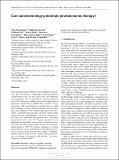Can nanotechnology potentiate photodynamic therapy?
Author(s)
Huang, Ying-Ying; Sharma, Sulbha K.; Dai, Tianhong; Chung, Hoon; Yaroslavsky, Anastasia; Garcia-Diaz, Maria; Chang, Julie; Chiang, Long Y.; Hamblin, Michael R; ... Show more Show less
DownloadHuang-2012-Can nanotechnology p.pdf (2.423Mb)
PUBLISHER_POLICY
Publisher Policy
Article is made available in accordance with the publisher's policy and may be subject to US copyright law. Please refer to the publisher's site for terms of use.
Terms of use
Metadata
Show full item recordAbstract
Photodynamic therapy (PDT) uses the combination of nontoxic dyes and harmless visible light to produce reactive oxygen species that can kill cancer cells and infectious microorganisms. Due to the tendency of most photosensitizers (PS) to be poorly soluble and to form nonphotoactive aggregates, drug-delivery vehicles have become of high importance. The nanotechnology revolution has provided many examples of nanoscale drug-delivery platforms that have been applied to PDT. These include liposomes, lipoplexes, nanoemulsions, micelles, polymer nanoparticles (degradable and nondegradable), and silica nanoparticles. In some cases (fullerenes and quantum dots), the actual nanoparticle itself is the PS. Targeting ligands such as antibodies and peptides can be used to increase specificity. Gold and silver nanoparticles can provide plasmonic enhancement of PDT. Two-photon excitation or optical upconversion can be used instead of one-photon excitation to increase tissue penetration at longer wavelengths. Finally, after sections on in vivo studies and nanotoxicology, we attempt to answer the title question, “can nanotechnology potentiate PDT?”
Date issued
2012-03Department
Institute for Medical Engineering and Science; Harvard University--MIT Division of Health Sciences and TechnologyJournal
Nanotechnology Reviews
Publisher
Walter de Gruyter
Citation
Huang, Ying-Ying et al. “Can Nanotechnology Potentiate Photodynamic Therapy?” Nanotechnology Reviews 1.2 (2012): n. pag. © 2012 Walter de Gruyter
Version: Final published version
ISSN
2191-9097
2191-9089